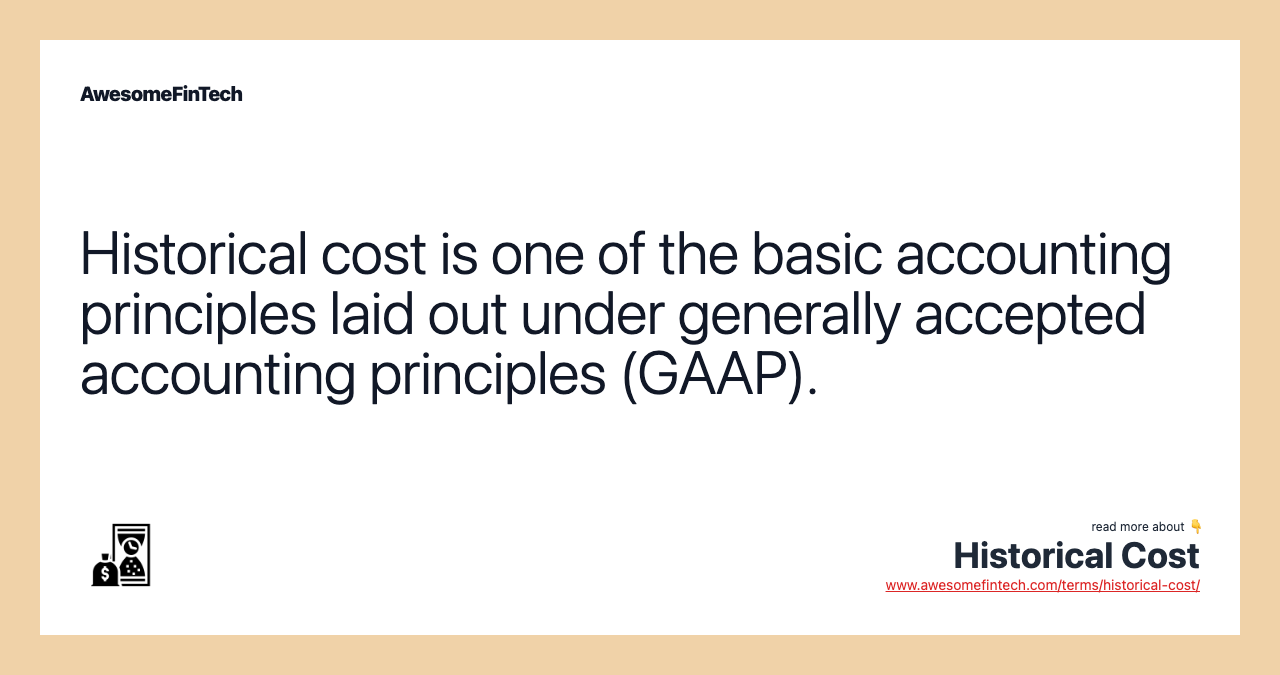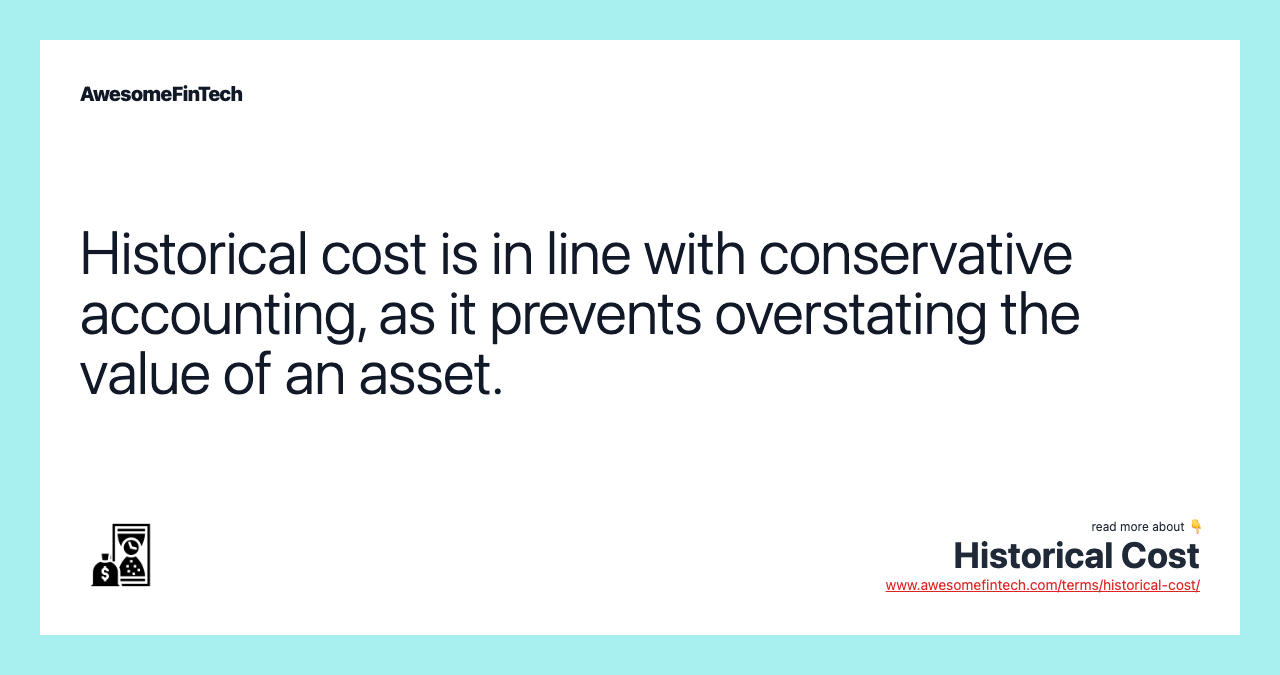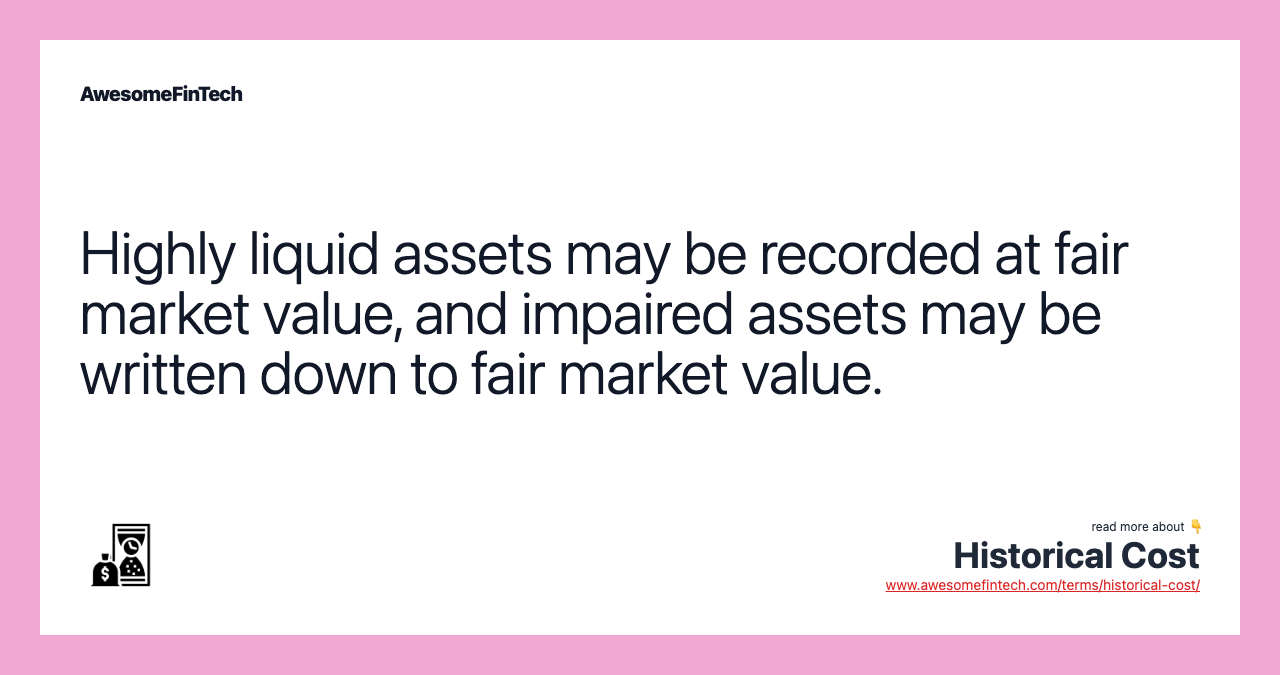Historical Cost
A historical cost is a measure of value used in accounting in which the value of an asset on the balance sheet is recorded at its original cost when acquired by the company. The historical cost method is used for fixed assets in the United States under generally accepted accounting principles (GAAP). Most long-term assets are recorded at their historical cost on a company's balance sheet. Historical cost is one of the basic accounting principles laid out under generally accepted accounting principles (GAAP). Historical cost is in line with conservative accounting, as it prevents overstating the value of an asset. For example, marketable securities are recorded at their fair market value on the balance sheet, and impaired intangible assets are written down from historical cost to their fair market value. A historical cost is a measure of value used in accounting in which the value of an asset on the balance sheet is recorded at its original cost when acquired by the company. Highly liquid assets may be recorded at fair market value, and impaired assets may be written down to fair market value.

What Is a Historical Cost?
A historical cost is a measure of value used in accounting in which the value of an asset on the balance sheet is recorded at its original cost when acquired by the company. The historical cost method is used for fixed assets in the United States under generally accepted accounting principles (GAAP).




Understanding Historical Costs
The historical cost principle is a basic accounting principle under U.S. GAAP. Under the historical cost principle, most assets are to be recorded on the balance sheet at their historical cost even if they have significantly increased in value over time. Not all assets are held at historical cost. For example, marketable securities are recorded at their fair market value on the balance sheet, and impaired intangible assets are written down from historical cost to their fair market value.
Valuing assets at historical cost prevents overstating an asset's value when asset appreciation may be the result of volatile market conditions. For example, if a company's main headquarters, including the land and building, was purchased for $100,000 in 1925, and its expected market value today is $20 million, the asset is still recorded on the balance sheet at $100,000.
Asset Depreciation
Furthermore, in accordance with accounting conservatism, asset depreciation must be recorded to account for wear and tear on long-lived assets. Fixed assets, such as buildings and machinery, will have depreciation recorded on a regular basis over the asset's useful life. On the balance sheet, annual depreciation is accumulated over time and recorded below an asset's historical cost. The subtraction of accumulated depreciation from the historical cost results in a lower net asset value, ensuring no overstatement of an asset's true value.
Asset Impairment vs. Historical Cost
Independent of asset depreciation from physical wear and tear over long periods of use, an impairment may occur to certain assets, including intangibles such as goodwill. With asset impairment, an asset's fair market value has dropped below what is originally listed on the balance sheet. An asset impairment charge is a typical restructuring cost as companies reevaluate the value of certain assets and make business changes.
For example, goodwill must be tested and reviewed at least annually for any impairment. If it is worth less than carrying value on the books, the asset is considered impaired. If it has risen in value, no change is made to historical cost. In the case of impairment, the devaluation of an asset based on present market conditions would be a more conservative accounting practice than keeping the historical cost intact. When an asset is written off due to asset impairment, the loss directly reduces a company's profits.
Mark-to-Market vs. Historical Cost
The mark-to-market practice is known as fair value accounting, whereby certain assets are recorded at their market value. This means that when the market moves, the value of an asset as reported in the balance sheet may go up or down. The deviation of the mark-to-market accounting from the historical cost principle is actually helpful to report on held-for-sale assets.
An asset's market value can be used to predict future cash flow from potential sales. A common example of mark-to-market assets includes marketable securities held for trading purposes. As the market swings, securities are marked upward or downward to reflect their true value under a given market condition. This allows for a more accurate representation of what the company would receive if the assets were sold immediately, and it is useful for highly liquid assets.
Related terms:
Accounting Conservatism
Accounting conservatism is a principle that requires company accounts to be prepared with high degrees of verification. read more
Accumulated Depreciation
Accumulated depreciation is the cumulative depreciation of an asset up to a single point in its life. read more
Balance Sheet : Formula & Examples
A balance sheet is a financial statement that reports a company's assets, liabilities and shareholder equity at a specific point in time. read more
Capitalization
Capitalization is an accounting method in which a cost is included in the value of an asset and expensed over the useful life of that asset. read more
Capital Lease
A capital lease is a contract entitling a renter the temporary use of an asset and, in accounting terms, has asset ownership characteristics. read more
Depreciation
Depreciation is an accounting method of allocating the cost of a tangible asset over its useful life and is used to account for declines in value over time. read more
Fair Value
Fair value can refer to the agreed price between buyer and seller or, in the accounting sense, the estimated worth of various assets and liabilities. read more
Fixed Asset
A fixed asset is a long-term tangible asset that a firm owns and uses to produce income and is not expected to be used or sold within a year. read more
Generally Accepted Accounting Principles (GAAP)
GAAP is a common set of generally accepted accounting principles, standards, and procedures that public companies in the U.S. must follow when they compile their financial statements. read more
Goodwill Impairment
Goodwill impairment is an accounting charge that companies record when goodwill's carrying value on financial statements exceeds its fair value. read more